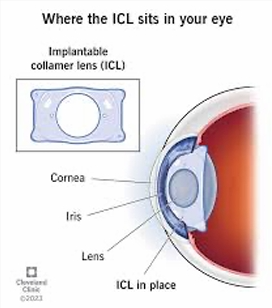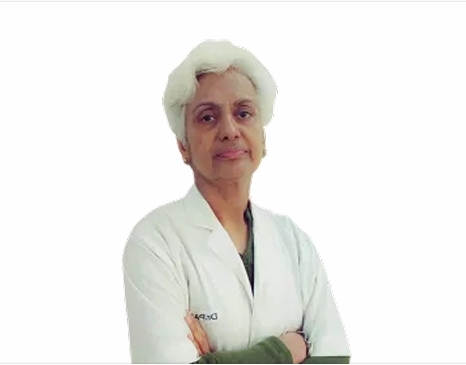Refractive surgery
Refractive surgery is a surgical procedure performed to correct the refractive error (spectacle power) of the eye. It is usually done to get rid of or reduce dependence on glasses and contact lens . It can be performed in a patient with stable refraction (glass power) after the age of 18 – 21 years. Complete medical history along with detailed eye examination is mandatory in all candidates, special Investigations like corneal topography (Pentacam, Orbscan), Anterior segment Optical Coherence Tomography (ASOCT) are performed to evaluate the shape, thickness and curvature of the cornea and other dimensions of the
eye. After acquiring all the details, the eye surgeon (ophthalmologist) makes a decision regarding the available options of refractive surgery for the patient. The current refractive procedures can be classified as Corneal procedures and Lens based surgery

PRK (Photrefractive Keratectomy)
This procedure involves careful removal of the top most layer of the cornea also known as epithelium , this is followed by Excimer laser delivery which reshapes
the corneal surface – to correct the refractive power of the eye. A contact lens is placed for a few days to support the healing of the eye, the epithelium is very
thin and usually grows back within 3 days
LASIK (Flap Based Procedure)
This is a very popular procedure and involves creation of a flap in the superficial layer of the cornea

SILK
In our swiftly progressing world of eye care, groundbreaking innovations are reshaping the landscape of refractive surgeries. At the vanguard of this transformation is the “SILK Procedure” by Johnson & Johnson, USA. Not only oes it promise a superior supervision quality of 6/5 vision, but its unique flapless methodology also sets a new benchmark, introducing a fresh paradigm in vision correction techniques.
Immediate Recovery Coupled with Ultimate Safety
The SILK Procedure is lauded for its notably quick recovery time. Imagine undergoing an eye surgery today and seamlessly transitioning back to your daily life tomorrow! The flapless nature of the SILK Procedure further enhances its safety quotient, positioning it as a leading choice among modern eye surgeries.
The Future in Sight: Bladeless, Painless, and Stitchless
SILK stands as a beacon of modern medical innovation by delivering a bladeless, painless, and stitchless experience. Eliminating the discomfort often linked with injections, the procedure employs eye drops for numbing. Within a concise span of 10 minutes, a lenticule of corneal tissue is crafted using advanced laser technology and subsequently removed through a micro opening.
The Sophistication of the ELITA Laser Machine
Central to the SILK procedure’s success is the sophisticated ELITA Laser Machine. With patients ensconced in comfort, this cutting-edge device ensures unmatched precision and efficiency throughout the procedure.
Addressing the Concern of Dry Eyes
A common post-operative issue in many eye surgeries is the onset of dry eyes.
However, with the SILK procedure, this concern sees a significant reduction, further amplifying its esteemed position in the field.
Silk Eye Surgery Cost in India
The cost of SILK eye surgery is Rs 1,25,000 in India, for both the eyes. It can vary depending upon the hospital and the surgeon
CONTOURA LASIK
In the healthcare industry, advanced technologies are developed to make patients’ lives easier and healthier, Thus technological improvements are essential in this sector. Scientists are working hard to develop surgical treatments with the fewest possible risks and the most excellent possible outcomes. Contoura Vision surgery, commonly called Topography- uided LASIK surgery, is one such sophisticated procedure, This procedure is a more sophisticated type of LASIK that offers more benefits to individuals considering spectacle removal surgery.Contoura Vision is an advanced LASIK technique that eliminates the need for eyeglasses. The 3-step correction technique, most importantly, provides a highly precise and accurate eye map, making it easier to mark up to 22,000 points. The USFDA has given its approval for the technology to be used to remove the specifications.
What Makes Contoura LASIK Unique?
This procedure is topography-guided, meaning the eye’s topography is mapped out ahead of time and used to provide a custom treatment that best fits the
eye’s shape. In some cases, patients who have abnormal corneal surfaces can make use of this treatment even when their corneal shape means they cannot
benefit from traditional LASIK.
SMILE (Small Incision Lenticule Extraction) Eye Surgery for Vision
Correction
Since the introduction and broad availability of LASIK surgery, advancements have continually been made. In 2012, a procedure called Small Incision
Lenticule Extraction, or SMILE, was introduced. This procedure is a type of refractive surgery that utilizes Femtosecond Laser. Instead of cutting a thin flap on the cornea, SMILE cuts and removes a thin corneal lenticule, and then removes it through a tiny incision ranging from 2 to 4 millimeters in a minimally
invasive procedure (Blade-free Vision Correction). Eye conditions that can be treated with SMILE surgery SMILE can be used to treat myopia with excellent results. It is currently performed by more than 750 surgeons around the world. The results of SMILE in the treatment of hyperopia and pure cylindrical corrections have still not been established. It was approved by FDA in 2016 to correct myopia upto 8 dioptres and cylinder upto 0.5 dioptres only. Even after revised approval of FDA in 2018, it is still not approved to correct hyperopias and pure cylinders. SMILE may be used to treat short-sightedness alone or short-sightedness with the presence of some astigmatism.
Wavefront-LASIK (Custom LASIK)
Custom LASIK is the most advanced laser technology available. Custom LASIK laser treatments are based upon the unique visual characteristics of your eye. Up until now, with glasses, contacts and conventional LASIK surgery,
corrections were quite similar for each type of prescription. Custom LASIK involves measuring the eye from front to back with a special laser, using what’s called “wavefront” technology, to create a three-dimensional (3-D) image of the eye. The information contained in the wavefront-map guides the laser in customizing the treatment to your individual visual system.
Possible benefits of custom LASIK
Custom LASIK wavefront technology is revolutionary because it has the potential to improve not only the quantity of your vision (i.e. the visual acuity measured by the standard 20/20 Snellen eye chart), but also the quality of how well you can see (i.e. visual acuity measured in terms of contrast sensitivity and fine vision). This may translate into a reduced risk of post-LASIK untoward side-effects, such as difficulty with night vision.
Implantable Collamer Lens (ICL)
This surgery involves placing an artificial implantable contact lens in front of the natural crystalline lens in the eye. ICL are made of biocompatible material
known as collamer (combination of collagen + polymer) and are very different from disposable contact lenses that are used routinely

Refractive lens exchange
In Refractive lens exchange the natural crystalline lens of the eye is removed and is replaced by an artificial intraocular lens (IOL) of the correct power. This procedure extracts the natural lens from the eye using Ultrasonic energy (Phacoemulsification) , hence there is no need
of cataract surgery in the future. Femtosecond laser platform can be used to assist in refractive lens exchange procedure and this is
popularly known as ROBOTIC -Refractive Lens Exchange. All patients of refractive surgery are started on an antibiotic – steroid combination
of eye drops along with lubricants and protective glasses. Close review of patients on post operative day 1, 3, 7 and 14 is mandatory along with regular follow-up after
Note:
It’s imperative to consult with a healthcare professional before opting for any medical procedure to thoroughly understand the potential risks and benefits. Specs Removal Procedures







